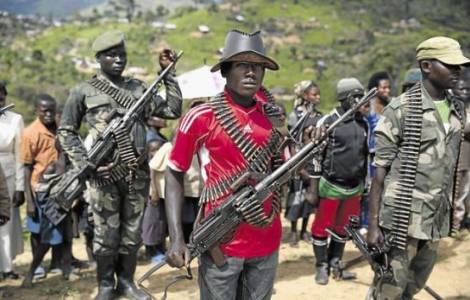AFRICA/UGANDA – The history of the emergence of the terrorist AFD militias: Between opportunism and “change of label”
by Luca Mainoldi
Kampala (Agenzia Fides) – The group responsible for the massacre at the school in Lhubiriha (Kasese district, western Uganda) on the night of June 17-18 (see Fides, 19/6/2023), has a complex history and has changed its name several times.
The ADF (Allied Democratic Forces) emerged around 1995 from the union of two groups, each with different ideological bases.
The first members of the ADF militias were former members of the Tabligh sect, which had been active in Uganda since at least the 1970s and had received financial support from Sudan after the fall of Idi Amin in 1979. The Islamic Tabligh emerged in British-ruled India in the early 20th century as a conservative movement to revitalize Islamic values and practices, with a strong emphasis on missionary work. Although most Tabligh supporters oppose armed jihadism, some of its members have joined radical Islamic groups.
In Uganda, some members of the Tabligh sect professed Salafism and went to Saudi Arabia to study thanks to special scholarships. Among them was Jamil Mukulu, who later became the leader of the ADF. Born into a Christian family, he converted to Islam in his youth, went to Riyadh to study and returned to Uganda with a militant view of Islam.
Initially imprisoned by local authorities in 1994, Mukulu founded the Ugandan Freedom Fighters Movement (UFFM) after his release in Hoima in western Uganda, which was supported by the Sudanese government, which was at loggerheads with the Ugandan government at the time.
When their camps were attacked by the Ugandan army in 1995, Mukulu fled to Kenya while another UFFM leader, Yusuf Kabanda, relocated the group to eastern Zaire, now the Democratic Republic of the Congo. Here Kabanda formed an alliance with the Ugandan rebel group “National Army for the Liberation of Uganda” (NALU). The NALU took over the earlier Ugandan rebellion of the Rwenzururu militias aimed at restoring the traditional supremacy of the Bakonjo and Baamba communities in western Uganda. These ethnic groups are linked to the Nande and Talinga ethnic groups of eastern DRC, with whom they share language and culture.
The merger of the two groups created the ADF-NALU, which fit into the complex dynamics in eastern DRC and was backed by then-Zairian President Mobutu Sese Seko to wage a proxy war against the Ugandan regime of Yoweri Museveni. After the overthrow of Mobutu, the ADF-NALU had to relocate to the Bambuba-Kisika faction north of the city of Beni, where they established ties with the local Vuba population. Many Vuba eventually joined the ADF-NALU, while the rebel leaders married women from this ethnic group, and started collaborations in the land field and in the trafficking of gold and timber.
After ups and downs, the secular component of the Ugandan rebellion (the NALU group) gave up armed struggle in 2007 thanks to an agreement with the Ugandan government to recognize the Kingdom of Rwenzururu. The leadership of the ADF, on the other hand, strengthened its radical Islamist orientation and introduced a strict regime based on Sharia within its ranks. In response to the Congolese military’s operations to neutralize the ADF, which had established itself between North Kivu and Ituri (two eastern Congolese provinces), the ADF responded with cruel reprisals against the civilian population. Among other things, in the raids on Congolese villages, several children were kidnapped and subsequently recruited into the ranks of the ADF, so that the group, although its leadership is still of Ugandan origin, also counts Congolese fighters in its ranks, including soldiers who are still children, and others who are now adults.
Despite emphasizing the group’s “Islamist” character, the ADF remains allied with other local armed groups, such as the Vuba militia, and even collaborates at times with the Congolese army.
In 2019, the ADF announced their affiliation with the Islamic State and henceforth called themselves “Madina in Tauheed Wau Mujahedeen” (MTM). The movement sought to reach a larger audience in East Africa by releasing propaganda videos in Kiswahili, Luganda, Arabic, French and Kinyarwanda.
The links between the ADF and the Islamic State are not just propaganda. Until now, it has been assumed that the Islamic State merely claims some of the ADF’s actions as its “Central African Province” (ISCAP).
In a mid-June, however, a UN report published in 2023 states that the Islamic State has “financially supported the ADF since at least 2019, through a complex system of funding involving individuals in several countries on the continent, from Somalia to South Africa, Kenya and Uganda”. In addition, the ADF “sent combatants and/or collaborators on reconnaissance missions to expand their area of operations beyond North Kivu and Ituri provinces,” planning attacks as far as the Congolese capital of Kinshasa. (Agenzia Fides, 24/6/2023)
Share:
Source link : https://www.fides.org/en/news/73926-AFRICA_UGANDA_The_history_of_the_emergence_of_the_terrorist_AFD_militias_Between_opportunism_and_change_of_label
Author :
Publish date : 2023-06-24 07:00:00
Copyright for syndicated content belongs to the linked Source.






